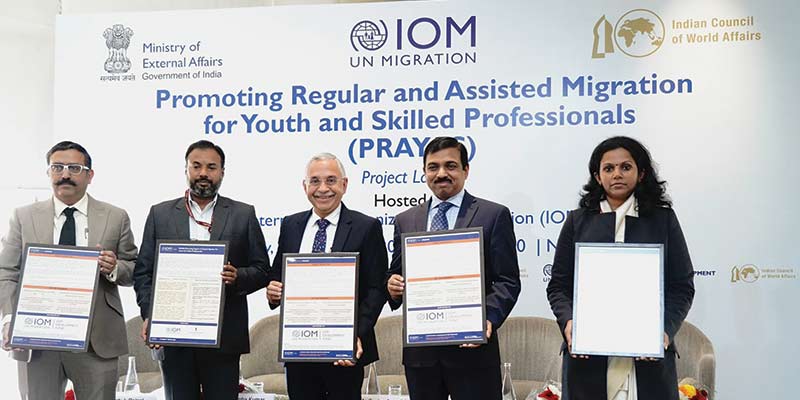- India
- Dec 26
What is Project PRAYAS?
• The International Organisation for Migration (IOM) and the ministry of external affairs launched a project named ‘Promoting Regular and Assisted Migration for Youth and Skilled Professionals’ (PRAYAS).
• The project envisages development of a roadmap for improved coordination between central and state governments to encourage sharing of best practices between states and enhanced engagement with the MEA on matters related to the international migration cycle.
• The project is a joint collaboration between the IOM India and Indian Council of World Affairs (ICWA).
• Project PRAYAS not only aligns with government of India’s priorities for the promotion of safe and orderly migration, but also aligns with Goal 10.7 of the 2030 Agenda for Sustainable Development Goals (SDGs) to facilitate orderly, safe, regular, and responsible migration and mobility of people.
• The project also adheres to the objectives of Global Compact for Safe, Orderly and Regular Migration (GCM) and the Migration Governance Framework (MiGOF).
What is the significance of this project?
• India is the largest recipient of remittances, with inflows likely to increase to $125 billion in 2023, according to the World Bank’s latest report.
• Well-managed emigration can thus be an unsung asset for origin states.
• However, the increase in immigration intake in destination countries in recent years has been accompanied by an increase in irregular migration, due to lack of awareness of, or faith in, regular channels. Additionally, increasingly, students are applying for higher education in countries abroad.
• State governments play a very important role in mobility management and welfare. Many states are invested in empowering outgoing migrants through pre-departure training instilling greater control over the pre-decision and pre-departure phases of migration and curbing mobility through informal channels.
• The ministry of external affairs (MEA) supports Project PRAYAS with the objective to contribute to facilitating safe, orderly, and regular migration for aspiring Indian migrant workers and students through policy recommendations in collaboration with the MEA, NITI Aayog, and state governments, thus facilitating better migration governance from India.
• This will be achieved through background research, discussions, and consultations with state governments and the MEA.
• Furthermore, the project will promote the dissemination of communication materials to aspiring students and migrant workers on safe and orderly migration pathways.
• This will strengthen the proactive engagement of state governments, encourage sharing of good practices and perspectives, facilitate the allocation of resources for emigrating migrants, and identify challenges and gaps, thereby enhancing the availability and flexibility for regular international migration pathways.
International Organisation for Migration (IOM)
• International Organisation for Migration (IOM) is the leading inter-governmental organisation in the field of migration and works closely with governmental and non-governmental partners.
• It was established in 1951.
• It was originally formed as the Provisional Intergovernmental Committee for the Movement of Migrants from Europe (PICMME) in 1951 out of the chaos and displacement of Western Europe following the Second World War.
• Mandated to help European governments to identify resettlement countries for the estimated 11 million people uprooted by the war, it arranged transport for nearly a million migrants during the 1950s.
• A succession of name changes from PICMME to the Intergovernmental Committee for European Migration (ICEM) in 1952, to the Intergovernmental Committee for Migration (ICM) in 1980 to the International Organisation for Migration (IOM) in 1989, reflects the organisation’s transition over half a century from logistics agency to migration agency.
• From its roots as an operational logistics agency, it has broadened its scope to become the leading international agency working with governments and civil society to advance the understanding of migration issues, encourage social and economic development through migration, and uphold the human dignity and well-being of migrants.
• In 2016, IOM entered into an agreement with the United Nations, becoming a ‘related organisation’.
• IOM serves as coordinator of the UN network on migration, established by the Secretary-General in 2018.
• The headquarters of IOM is situated in Geneva, Switzerland.
• Currently, IOM has 175 Member States and a further 8 states holding Observer status.
• The organisation is guided by the principles enshrined in the Charter of the United Nations, including upholding human rights for all. Respect for the rights, dignity and well-being of migrants remains paramount.
• The IOM Constitution recognises the link between migration and economic, social and cultural development, as well as to the right of freedom of movement.
IOM works in four broad areas:
i) Migration and development
ii) Facilitating migration
iii) Regulating migration
iv) Forced migration.
Manorama Yearbook app is now available on Google Play Store and iOS App Store


